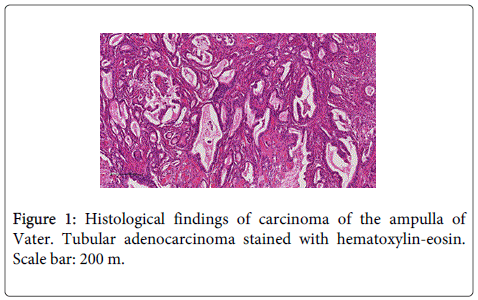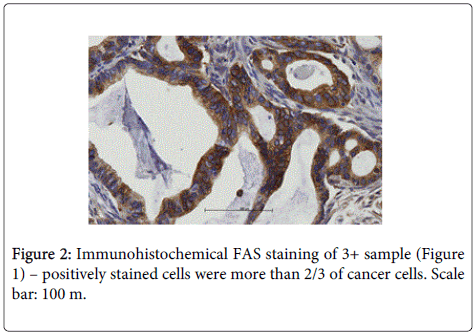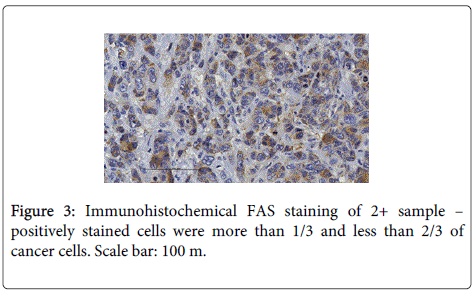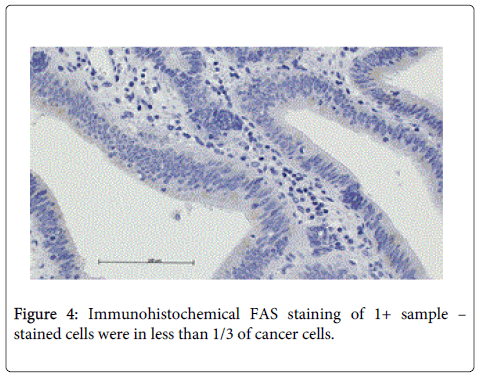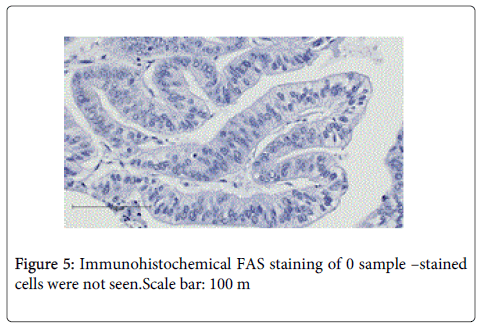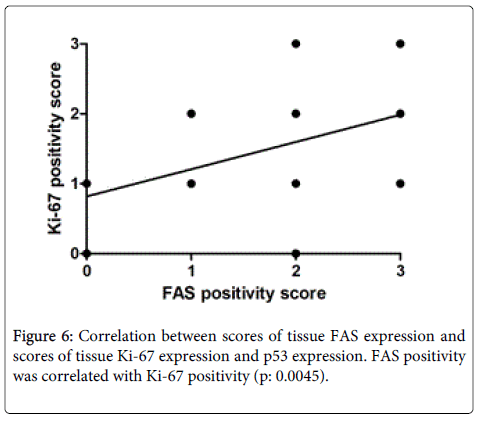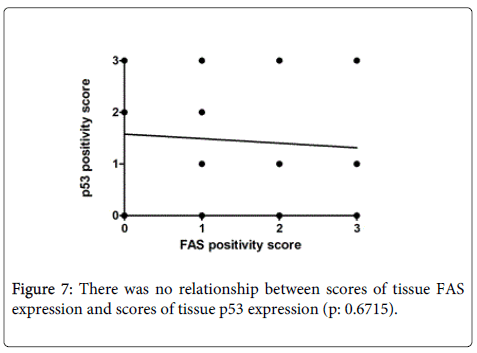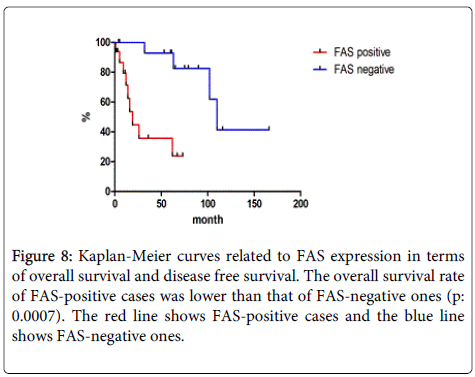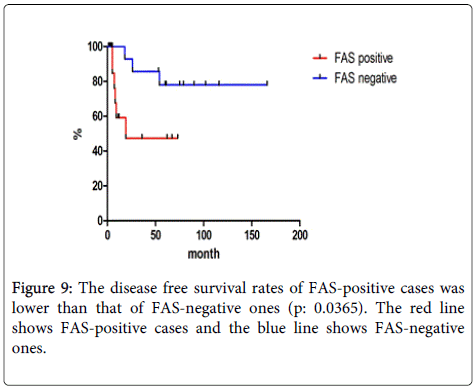Research Article Open Access
Clinicopathological Significance of Fatty Acid Synthase Expression in Carcinoma of the Ampulla of Vater
Hiroshi Maekawa*, Tomoaki Ito, Tomoyuki Kushida, Hajime Orita, Mutsumi Sakurada and Koichi Sato
Department of Surgery, Juntendo university school of medicine Shizuoka hospital, 1129, Nagaoka, Izu-no-kuni, Shizuoka, Japan
- Corresponding Author:
- Hiroshi Maekawa
Department of Surgery
Juntendo university school of medicine Shizuoka hospital
1129, Nagaoka, Izu-no-kuni, Shizuoka, Japan
Tel: 81 559483111
Fax: 81 559460514
E-mail: hmaekawa0201@gmail.com
Received Date: January 2, 2015; Accepted Date: January 19, 2015; Published Date: January 30, 2015
Citation: Maekawa H, Ito T, Kushida T, Hajime Orita H, Sakurada M, et al. (2015) Clinicopathological Significance of Fatty Acid Synthase Expression in Carcinoma of the Ampulla of Vater. J Gastrointest Dig Syst 5:251. doi:10.4172/2161-069X.1000251
Copyright: © 2015 Maekawa H, et al. This is an open-access article distributed under the terms of the Creative Commons Attribution License, which permits unrestricted use, distribution, and reproduction in any medium, provided the original author and source are credited.
Visit for more related articles at Journal of Gastrointestinal & Digestive System
Abstract
Objective: Increased fatty acid synthase (FAS) expression is detected in various cancers. It has been demonstrated that the intensity of FAS expression in cancer correlates with clinical outcome. Here, we investigated whether FAS expression in carcinoma of the ampulla of Vater has any relationship to clinical or pathological features.
Methods: We studied 32 patients surgically treated for carcinoma of the ampulla of Vater in our hospital. We compared FAS immunohistochemical staining with other pathological features, including Ki-67, p53, and MUC1, and 2 staining, and with clinical findings.
Results: Of these 32 cases, 16 were considered FAS-positive under our criteria. Pathologically, FAS positivity was correlated to Ki-67 positivity (p: 0.0045), but there was no significant relationship between FAS expression and p53 staining(p: 0.6715). FAS-positive cases showed a higher rate of lymph node metastases (p: 0.0373). However, FAS expression was not related to tumor size, differentiation of adenocarcinoma, duodenal invasion, pancreatic invasion and MUC1 or MUC2 positivity. Clinically, the disease survival rate and the overall survival rate of FAS-positive cases was lower than that of FAS-negative ones (p: 0.0365, 0.0007).
Conclusion: Histological FAS expression is related to aggressiveness of cancer of the ampulla of Vater and FAS expression can be considered to be a prognostic marker in cancer of the ampulla of Vater.
Keywords
Cancer; The ampulla of Vater; Fatty acid synthase; Immunohistochemistry; Prognosis
Introduction
Fatty acid synthase (FAS) expression is normally regulated and inhibited by several hormones in normal tissues [1] and FAS is usually expressed in hormone-sensitive and high-lipid-metabolism cells in humans [2]. Overexpression of FAS was initially reported in breast cancer [3]. Subsequently, increased FAS expression was also reported in various other cancers [4-7]. FAS expression increases the de novo biosynthesis of fatty acids, which contributes to tumor cellular activities [8]; as well as metabolism for energy production, building cellular membranes, and intracellular secondary messengers [9,10]. It has been demonstrated that the intensity of FAS expression in cancer correlates with clinical outcome [4,11-16]. That is, cases with high FAS expression often show poor prognoses in various kinds of cancer [4,11-16].
Biliary tract cancer is regarded as one of the cancers with poor prognoses in clinical practice [17]. Carcinoma of the ampulla of Vater is one of the carcinomas that occur in the biliary tract. The prognosis of carcinoma of the ampulla of Vater is considered to be better than those of carcinomas derived from other parts of the biliary tract or pancreatic head [17-19]. However, recurrence of carcinoma of the ampulla of Vater occurs even though the curative resection has been performed [17-19].
However, FAS expression in cancer of the ampulla of Vater has not been reported. It is unclear whether FAS is also expressed in carcinoma of the ampulla of Vater, and whether FAS expression has any relationship to the clinical outcome of this type of carcinoma. The aim of this study is thus to investigate the relationship between the expression of FAS and clinicopathological features using immunohistochemistry in carcinoma of the ampulla of Vater. Then, we considered whether FAS could be regarded as a prognostic marker in this type of carcinoma.
Materials and Methods
Samples
We studied 32 patients who underwent resection for carcinoma of the ampulla of Vater between January 2002 and January 2014 in our hospital. Pathological diagnoses were performed by hematoxylin and eosin staining. We investigated the expression of FAS, Ki-67, p53, and MUC1, and MUC2 on tissue sections cut from carcinoma specimens formalin-fixed and paraffin-embedded by immunohistochemical staining. Pathological aspects, tumor size, node metastases, tumor differentiation, duodenal invasion, pancreatic invasion, Ki-67, p53 staining, and MUC1, and MUC2 expression were also compared with FAS expression. We compared FAS expression with clinical information. Clinical data such as gender, age, preoperative serum CA19-9 level, diabetes mellitus complication and prognoses were obtained from the clinical records. The study protocol conformed to the ethical guidelines of the World Medical Association Declaration of Helsinki, and has been approved by the ethical committee of our hospital.
Immunohistochemical studies
We used 4-m tissue sections cut from specimens that had been formalin-fixed and paraffin-embedded. Immunohistochemical staining was performed using an automated slide stainer (Bench-Mark XT; Ventana Medical Systems Inc., Tucson, AZ) [20,21]. Anti-human FAS rabbit IgG was obtained from Immuno-Biological Laboratories Co., Ltd. (Fujioka, Gunma, Japan). Monoclonal mouse anti-human Ki-67 and p53 antigens were obtained from Dako (Carpinteria, CA, USA). Monoclonal mouse anti-human MUC1 and MUC2 antigens were obtained from Dako (Carpinteria, CA, USA).
Staining intensity was measured according to the classification previously described [22,23], as 0, negative staining; 1+, low staining for up to 1/3 of cells stained; 2+, moderate staining for up to 2/3 of cells stained; and 3+, intense staining for more than 2/3 of cells stained. For statistical analysis we used a method that the results were dichotomized as high (3+ and 2+) or low (1+ and 0) expression (Figures 1-5).
Cancer of the ampulla of Vater expressed MUC1 or MUC2. MUC1-positive cases were determined as those predominantly stained with MUC1 antibody. MUC2-positive cases were determined in the same fashion.
Statistical analysis
Relationships of the scores of tissue FAS expression and those of tissue Ki-67 expression or those of tissue p53 expression were analyzed using Spearman’s correlation coefficient by rank test. Cut-off end-points were determined according to positive and negative immunohistochemical tissue FAS expressions observed. FAS positivity was tested for association with clinicopathological features using Fisher’s exact test or Mann-Whitney’s test. Overall survival rate and disease-free survival rate were plotted using the Kaplan-Meier method. These survival rates were analyzed using log-rank test. All analyses were conducted using the GraphPad Prism5® statistical software package (GraphPad Software Inc., La Jolla, CA, USA).
We estimated survival based on FAS expression patterns using the Kaplan-Meier analysis and compared survival between groups using log-rank tests. A p value less than 0.05 was considered significant.
Results
The clinical features of the 32 cases were listed (Table 1). All 32 cases had adenocarcinoma and recurrences were noted in 10 patients, and they died due to carcinoma of the ampulla of Vater. A total of 16 cases were positive for FAS staining and 16 were negative.
| Gender (Male/Female) | 16 / 16 |
| Age (mean) | 66.9 |
| Clinical Stages (UICC 6th edition) (cases) | IA 7/ IB 12/IIA 5/IIB 5 /IV 3 |
| Recurrence (cases) | 10 |
| Follow-up (month) | 46.8 (2-166) |
| Number of cases with each score (FAS staining score 0/1/2/3) | 9/7/10/6 |
Table 1: Clinical Features of 32 Carcinoma of the Ampulla of Vater Cases.
The correlation between scores of tissue FAS expression and scores of tissue Ki-67 expression was analyzed (Figures 6 and 7). FAS positivity was correlated with Ki-67 positivity (p: 0.0045). Next, we analyzed the correlation between scores of tissue FAS expression and scores of tissue p53 expression. There was no relationship between these two variables (p: 0.6715).
Pathological features of carcinoma of the ampulla of Vater according to FAS positivity were listed on Table 2. FAS-positive cases showed higher rates of lymph node metastases (p: 0.0373). However, FAS expression was not related to tumor size, differentiation of adenocarcinoma, duodenal invasion, pancreatic invasion.
| Pathological features | FAS-positive 16 cases | FAS-negative 16 cases | p value |
|---|---|---|---|
| Tumor size (mm) | 24.7 | 21.1 | 0.4672 |
| Node metastasis (%) | 43.8 | 6.3 | 0.0373 |
| Differentiation (well/moderate/poor) | 14/2/0 | 12/2/2002 | 0.3406 |
| Ki-67 positivity (%) | 62.5 | 43.8 | 0.4795 |
| P53 positivity (%) | 31.3 | 62.5 | 0.1556 |
| Duodenal invasion | 81.3 | 56.3 | 0.2524 |
| Pancreatic invasion | 37.5 | 18.8 | 0.4331 |
| MUC 1 / MUC 2 | 6-Oct | 9-Jul | 0.4595 |
Table 2: Pathological features of carcinoma of the ampulla of Vater according to FAS immunohistochemical staining.
There were no significant differences between the two groups in terms of Ki-67 positivity, p53 positivity. MUC1-positive cases were seventeen and MUC2-positive cases were fifteen. Ten cases (58.8 %) were FAS-positive in MUC1-positive cases.
6 cases (40%) were FAS-positive in MUC2-positive cases. There was no significant difference between FAS positivity and MUC1 or MUC2 positivity.
The clinical features of the two groups were also analyzed. There were no significant differences between the two groups in terms of gender, age, and preoperative level of CA19-9, diabetes mellitus complication. Recurrences were seen in both FAS-positive and FAS-negative groups.
Overall survival rate and disease-free survival are shown using the Kaplan-Meier method in Figures 8 and 9. The overall survival rate and the disease survival rate of FAS-positive cases were lower than that of FAS-negative ones (p: 0.0007, 0.0365).
Discussion
Pathological prognostic factors of carcinoma of the ampulla of Vater have been reported including lymph node metastases [24-28], ulceration form [25-27,29], tumor differentiation [27] and tumor size [25]. These factors are clinically convenient and useful for management of patients of carcinoma of the ampulla of Vater.
Furthermore, immunohistochemical researches to detect the prognostic factors of this type of cancer have been studied and reported. MIB-1 labeling index and p53 were investigated, same as in this study. Shyr et al. reported that MIB-1 index had prognostic value in resectable carcinoma of the ampulla of Vater, although they did not show the relationship between MIB-1 index and clinical stage and lymph node metastases [30]. The prognostic value of p53 expression has also been reported in several manuscripts. However, it was not clear whether p53 had a possible role in predicting survival [31-35].
Immunohistochemical analyses on the expression of keratin, apomucin subtypes for detecting prognostic factors of carcinoma of the ampulla of Vater have been performed, and those immunohistochemical features were related to the prognoses of carcinoma of the ampulla of Vater [28,29,36,37]. Kimura et al. demonstrated that analysis using keratin7 and MUC2 was useful for the prediction of prognoses in cases of carcinoma of the ampulla of Vater [36,37]. They concluded that prognoses of keratin7-positive cases showed worse than those of MUC2-positive cases. That meant that pancreatobiliary-type adenocarcinoma was highly aggressive compared with the intestinal-type. They also reported pancreatobiliary-type carcinomas showed more frequent involvement of lymph nodes that was responsible for the shorter survival time. However, Catrer et al. reported that there was no significant difference in node metastases between pancreatobiliary-type and intestinal-type [28]. Relation node metastasis and pancreatobiliary- or intestinal- subtypes classification is considered to be still controversial.
In this study, we found that FAS expression is associated with tumor aggressiveness in carcinoma of the ampulla of Vater and had relation to lymph node metastases and their prognoses. That is, FAS expression in carcinoma of the ampulla of Vater is also useful for predicting prognosis, the same as in MIB-1 labeling index and keratin, apomucin subtypes [28,30,36,37]. Our result showed FAS expression had a significant relation to Ki-67 expression and node metastases. However, we could not find any significant relationship between MUC1 or MUC2 positivity and FAS positivity. Our study contains a small number of samples, so we need to accumulate more cases for further consideration in order to determine the relationship between pancreatobiliary- or intestinal- subtypes classification and FAS expression.
Recently, FAS has been said to play an important role not only in tumor growth, but also in drug resistance [38,39]. Both cellar proliferation and drug resistance can contribute cancer survival. Theses abilities are based of elevated FAS activity [40]. From previous reports and our results, it is suspected that FAS expression is related to cancer aggressiveness. FAS-positive expression can be considered to be a prognostic marker of cancer.
Conclusion
FAS expression may be related to clinical behavior in carcinoma of the ampulla of Vater. Histologically, positive FAS expression related to high incidence of lymph node metastases and poor prognoses. Histological FAS expression can be a prognostic factor in carcinoma of the ampulla of Vater same as other types of carcinoma.
References
- Sul HS, Wang D (1998) Nutritional and hormonal regulation of enzymes in fat synthesis: studies of fatty acid synthase and mitochondrial glycerol-3-phosphate acyltransferase gene transcription.Annu Rev Nutr 18: 331-351.
- Kusakabe T, Maeda M, Hoshi N, Sugino T, Watanabe K, et al. (2000) Fatty acid synthase is expressed mainly in adult hormone-sensitive cells or cells with high lipid metabolism and in proliferating fetal cells.J Histochem Cytochem 48: 613-622.
- Kuhajda FP, Piantadosi S, Pasternack GR (1989) Haptoglobin-related protein (Hpr) epitopes in breast cancer as a predictor of recurrence of the disease.N Engl J Med 321: 636-641.
- Alo' PL, Visca P, Marci A, Mangoni A, Botti C, et al. (1996) Expression of fatty acid synthase (FAS) as a predictor of recurrence in stage I breast carcinoma patients.Cancer 77: 474-482.
- Wang YY, Kuhajda FP, Li J, Finch TT, Cheng P, et al. (2004) Fatty acid synthase as a tumor marker: its extracellular expression in human breast cancer.J Exp Ther Oncol 4: 101-110.
- Van de Sande T, Roskams T, Lerut E, Joniau S, Van Poppel H, et al. (2005) High-level expression of fatty acid synthase in human prostate cancer tissues is linked to activation and nuclear localization of Akt/PKB.J Pathol 206: 214-219.
- Shah US, Dhir R, Gollin SM, Chandran UR, Lewis D, et al. (2006) Fatty acid synthase gene overexpression and copy number gain in prostate adenocarcinoma.Hum Pathol 37: 401-409.
- Kuhajda FP (2006) Fatty acid synthase and cancer: new application of an old pathway.Cancer Res 66: 5977-5980.
- Liu H, Liu JY, Wu X, Zhang JT (2010) Biochemistry, molecular biology, and pharmacology of fatty acid synthase, an emerging therapeutic target and diagnosis/prognosis marker.Int J Biochem Mol Biol 1: 69-89.
- Mashima T, Seimiya H, Tsuruo T (2009) De novo fatty-acid synthesis and related pathways as molecular targets for cancer therapy.Br J Cancer 100: 1369-1372.
- Gansler TS, Hardman W 3rd, Hunt DA, Schaffel S, Hennigar RA (1997) Increased expression of fatty acid synthase (OA-519) in ovarian neoplasms predicts shorter survival.Hum Pathol 28: 686-692.
- Shurbaji MS, Kalbfleisch JH, Thurmond TS (1996) Immunohistochemical detection of a fatty acid synthase (OA-519) as a predictor of progression of prostate cancer.Hum Pathol 27: 917-921.
- Visca P, Sebastiani V, Botti C, Diodoro MG, Lasagni RP, et al. (2004) Fatty acid synthase (FAS) is a marker of increased risk of recurrence in lung carcinoma.Anticancer Res 24: 4169-4173.
- Sebastiani V, Visca P, Botti C, Santeusanio G, Galati GM, et al. (2004) Fatty acid synthase is a marker of increased risk of recurrence in endometrial carcinoma.Gynecol Oncol 92: 101-105.
- Ogino S, Nosho K, Meyerhardt JA, Kirkner GJ, Chan AT, et al. (2008) Cohort study of fatty acid synthase expression and patient survival in colon cancer.J Clin Oncol 26: 5713-5720.
- Alo PL, Amini M, Piro F, Pizzuti L, Sebastiani V, et al. (2007) Immunohistochemical expression and prognostic significance of fatty acid synthase in pancreatic carcinoma.Anticancer Res 27: 2523-2527.
- Schmidt CM, Powell ES, Yiannoutsos CT, Howard TJ, Wiebke EA, et al. (2004) Pancreaticoduodenectomy: a 20-year experience in 516 patients.Arch Surg 139: 718-725.
- Sommerville CA, Limongelli P, Pai M, Ahmad R, Stamp G, et al. (2009) Survival analysis after pancreatic resection for ampullary and pancreatic head carcinoma: an analysis of clinicopathological factors.J Surg Oncol 100: 651-656.
- Howe JR, Klimstra DS, Moccia RD, Conlon KC, Brennan MF (1998) Factors predictive of survival in ampullary carcinoma.Ann Surg 228: 87-94.
- Rosenbaum L, Fekrazad MH, Rabinowitz I, Vasef MA (2009) Epstein-Barr virus-associated inflammatory pseudotumor of the spleen: report of two cases and review of the literature.J Hematop 2: 127-131.
- Kataoka Y, Okabe H, Yoshizawa A, Minamiguchi S, Yoshimura K, et al. (2013) HER2 expression and its clinicopathological features in resectable gastric cancer.Gastric Cancer 16: 84-93.
- Ferreira SA, Vasconcelos JL, Silva RC, Cavalcanti CL, Bezerra CL, et al. (2013) Expression patterns of α2,3-sialyltransferase I and α2,6-sialyltransferase I in human cutaneous epithelial lesions.Eur J Histochem 57: e7.
- Clark ATR, Guimaraes da Costa VML, Costa LB, Cavalcanti CLB, de Melo Rego MJB et al. (2014) Differential expression patterns of N-acetyl-glucosaminyl transferases and polyactosamines in uterine lesions. Eur J Histochem 58: 152-157.
- de Castro SM, van Heek NT, Kuhlmann KF, Busch OR, Offerhaus GJ, et al. (2004) Surgical management of neoplasms of the ampulla of Vater: local resection or pancreatoduodenectomy and prognostic factors for survival.Surgery 136: 994-1002.
- Madjov R, Chervenkov P (2003) Carcinoma of the papilla of Vater. Diagnostic and surgical problems.Hepatogastroenterology 50: 621-624.
- Moriya T, Kimura W, Hirai I, Mizutani M, Ma J, et al. (2006) Nodal involvement as an indicator of postoperative liver metastasis in carcinoma of the papilla of Vater.J Hepatobiliary Pancreat Surg 13: 549-555.
- Park JS, Yoon DS, Kim KS, Choi JS, Lee WJ, et al. (2007) Factors influencing recurrence after curative resection for ampulla of Vater carcinoma.J Surg Oncol 95: 286-290.
- Carter JT, Grenert JP, Rubenstein L, Stewart L, Way LW (2008) Tumors of the ampulla of vater: histopathologic classification and predictors of survival.J Am Coll Surg 207: 210-218.
- Fischer HP, Zhou H (2004) Pathogenesis of carcinoma of the papilla of Vater.J Hepatobiliary Pancreat Surg 11: 301-309.
- Shyr YM, Su CH, Wu LH, Li AF, Chiu JH, et al. (1999) Prognostic value of MIB-1 index and DNA ploidy in resectable ampulla of Vater carcinoma.Ann Surg 229: 523-527.
- Santini D, Tonini G, Vecchio FM, Borzomati D, Vincenzi B, et al. (2005) Prognostic value of Bax, Bcl-2, p53, and TUNEL staining in patients with radically resected ampullary carcinoma.J Clin Pathol 58: 159-165.
- Park SH, Kim YI, Park YH, Kim SW, Kim KW, et al. (2000) Clinicopathologic correlation of p53 protein overexpression in adenoma and carcinoma of the ampulla of Vater.World J Surg 24: 54-59.
- Ajiki T, Kamigaki T, Hasegawa Y, Fujino Y, Suzuki Y, et al. (2001) Proliferating cell nuclear antigen, p53, and c-erbB-2 expression in relation to clinicopathological variables and prognosis in cancer of the ampulla of Vater.Hepatogastroenterology 48: 1266-1270.
- Takashima M, Ueki T, Nagai E, Yao T, Yamaguchi K, et al. (2000) Carcinoma of the ampulla of Vater associated with or without adenoma: a clinicopathologic analysis of 198 cases with reference to p53 and ki-67 immunohistochemical expression. Mod Pathol 13: 1300-1307.
- Guo R, Overman M, Chatterjee D, Rashid A, Shroff S, et al. (2014) Abberrant expression of p53, p21, cyclin D1, and bcl2 and their clinicopathological correlation in ampullary adenocarcinoma. Human Pathol 45: 1015-1023.
- Kimura W, Futakawa N, Zhao B (2004) Neoplastic diseases of the papilla of Vater.J Hepatobiliary Pancreat Surg 11: 223-231.
- Kimura W, Futakawa N, Yamagata S, Wada Y, Kuroda A, et al. (1994) Different clinicopathologic findings in two histologic types of carcinoma of papilla of Vater.Jpn J Cancer Res 85: 161-166.
- Liu H, Liu Y, Zhang JT (2008) A new mechanism of drug resistance in breast cancer cells: fatty acid synthase overexpression-mediated palmitate overproduction.Mol Cancer Ther 7: 263-270.
- Yang Y, Liu H, Li Z, Zhao Z, Yip-Schneider M, et al. (2011) Role of fatty acid synthase in gemcitabine and radiation resistance of pancreatic cancers.Int J Biochem Mol Biol 2: 89-98.
- Mounier C, Bouraoui L, Rassart E (2014) Lipogenesis in cancer progression (review).Int J Oncol 45: 485-492.
Relevant Topics
- Constipation
- Digestive Enzymes
- Endoscopy
- Epigastric Pain
- Gall Bladder
- Gastric Cancer
- Gastrointestinal Bleeding
- Gastrointestinal Hormones
- Gastrointestinal Infections
- Gastrointestinal Inflammation
- Gastrointestinal Pathology
- Gastrointestinal Pharmacology
- Gastrointestinal Radiology
- Gastrointestinal Surgery
- Gastrointestinal Tuberculosis
- GIST Sarcoma
- Intestinal Blockage
- Pancreas
- Salivary Glands
- Stomach Bloating
- Stomach Cramps
- Stomach Disorders
- Stomach Ulcer
Recommended Journals
Article Tools
Article Usage
- Total views: 14591
- [From(publication date):
February-2015 - Jul 11, 2025] - Breakdown by view type
- HTML page views : 10003
- PDF downloads : 4588

